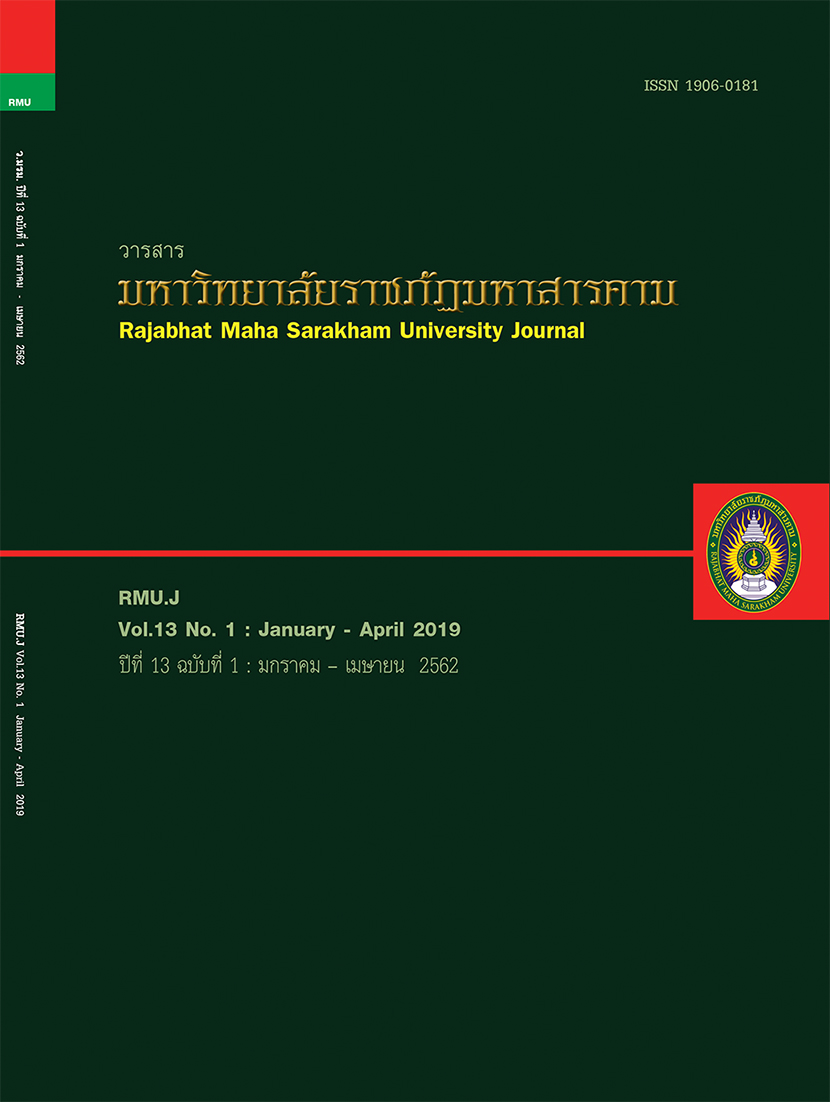รูปแบบการพัฒนาสมรรถนะทางการบริหารของผู้บริหารมหาวิทยาลัยมหาจุฬาลงกรณราชวิทยาลัย
Main Article Content
บทคัดย่อ
การวิจัยครั้งนี้มีวัตถุประสงค์ 1) เพื่อศึกษาระดับสมรรถนะทางการบริหารของผู้บริหาร 2) เพื่อศึกษาระดับความคิดเห็นเกี่ยวกับ
ปัจจัยที่มีอิทธิพลต่อสมรรถนะทางการบริหารของผู้บริหาร 3) เพื่อศึกษาปัจจัยเชิงสาเหตุที่มีอิทธิพลต่อสมรรถนะทางการบริหารของ
ผู้บริหาร และ 4) เพื่อสร้างรูปแบบการพัฒนาสมรรถนะทางการบริหารของผู้บริหารมหาวิทยาลัยมหาจุฬาลงกรณราชวิทยาลัย การวิจัย
แบ่งเป็น 2 ระยะ ได้แก่ ระยะที่ 1 การศึกษาปัจจัยเชิงสาเหตุที่มีอิทธิพลต่อการพัฒนาสมรรถนะทางการบริหารของผู้บริหารมหาวิทยาลัย
มหาจุฬาลงกรณราชวิทยาลัย กลุ่มตัวอย่างที่ใช้ในการวิจัย คือ ผู้บริหารของมหาวิทยาลัยมหาจุฬาลงกรณราชวิทยาลัย จำนวน 300 คน
การกำหนดขนาดกลุ่มตัวอย่างใช้เกณฑ์ 20 หน่วยต่อ 1 ตัวแปร เครื่องมือที่ใช้เป็นแบบสอบถามมาตราส่วนประมาณค่า 5 ระดับ วิเคราะห์
ข้อมูลด้วยสถิติเชิงพรรณนา และการวิเคราะห์สมการเชิงโครงสร้าง (SEM) โดยโปรแกรมลิสเรล (LISREL) และระยะที่ 2 เป็นการสร้าง
รูปแบบและยืนยันรูปแบบการพัฒนาสมรรถนะทางการบริหารของผู้บริหารมหาวิทยาลัยมหาจุฬาลงกรณราชวิทยาลัย จากผู้มีความ
เชี่ยวชาญเฉพาะเรื่องตามเทคนิค CIT ผลการวิจัย พบว่า 1) ระดับสมรรถนะทางการบริหารของผู้บริหารมหาวิทยาลัยมหาจุฬาลงกรณ
ราชวิทยาลัย โดยภาพรวมอยู่ในระดับมาก เมื่อพิจารณาเป็นรายด้านพบว่า อยู่ในระดับมากทุกด้านโดยเรียงลำดับความสำคัญค่าเฉลี่ย
จากมากไปหาน้อยได้ ดังนี้ ด้านสมรรถนะการคิดเชิงยุทธศาสตร์ ด้านสมรรถนะการบริหารการเปลี่ยนแปลง ด้านสมรรถนะการสร้าง
ความร่วมมือ ด้านสมรรถนะการสื่อสาร และด้านสมรรถนะการพัฒนาบุคลากร ตามลำดับ 2) ความคิดเห็นเกี่ยวกับปัจจัยที่มีอิทธิพล
ต่อสมรรถนะทางการบริหารของผู้บริหารมหาวิทยาลัยมหาจุฬาลงกรณราชวิทยาลัย โดยภาพรวมอยู่ในระดับมาก เมื่อพิจารณาเป็น
รายด้าน พบว่า อยู่ในระดับมาก จำนวน 7 ด้าน โดยเรียงลำดับความสำคัญค่าเฉลี่ยจากมากไปหาน้อยได้ ดังนี้ การจัดการความรู้ เจตคติ
ภาวะผู้นำการเปลี่ยนแปลง ทักษะการบริหารทรัพยากรมนุษย์ ความฉลาดทางอารมณ์ การบริหารแบบมืออาชีพ และประสิทธิภาพ
การสื่อสาร และอยู่ในระดับปานกลาง จำนวน 2 ด้าน คือ แรงจูงใจใฝ่สัมฤทธิ์ และภาวะผู้นำเชิงศรัทธาบารมี ตามลำดับ3) ปัจจัยเชิง
สาเหตุที่มีอิทธิพลต่อการพัฒนาสมรรถนะทางการบริหารของผู้บริหารมหาวิทยาลัยมหาจุฬาลงกรณราชวิทยาลัย ได้แก่ ภาวะผู้นำการ
เปลี่ยนแปลง มีค่าสัมประสิทธิ์อิทธิพลโดยรวม เท่ากับ 0.37 การบริหารแบบมืออาชีพ มีค่าสัมประสิทธิ์อิทธิพลโดยรวม เท่ากับ 0.34
การจัดการความรู้ มีค่าสัมประสิทธิ์อิทธิพลโดยรวม เท่ากับ 0.24 ภาวะผู้นำเชิงศรัทธาบารมี มีค่าสัมประสิทธิ์อิทธิพลโดยรวม เท่ากับ
0.17 และความฉลาดทางอารมณ์ มีค่าสัมประสิทธิ์อิทธิพลโดยรวม เท่ากับ 0.17 สามารถพยากรณ์การพัฒนาสมรรถนะทางการบริหาร
ของผู้บริหารมหาวิทยาลัยมหาจุฬาลงกรณราชวิทยาลัย ได้ร้อยละ 31.10 (R2= 0.311, p-value ≤ .05) อย่างมีนัยสำคัญทางสถิติที่
ระดับ .05 และ 4) รูปแบบการพัฒนาสมรรถนะทางการบริหารของผู้บริหารมหาวิทยาลัยมหาจุฬาลงกรณราชวิทยาลัย ประกอบด้วย
4.1)การพัฒนาการบริหารแบบมืออาชีพ และ 4.2) การภาวะผู้นำเชิงศรัทธาบารมี ซึ่งทั้งสองประการมุ่งเน้นการส่งเสริมและผลักดันไป
สู่สมรรถนะของผู้บริหารมหาวิทยาลัยมหาจุฬาลงกรณราชวิทยาลัยให้ประสบความสำเร็จ โดยจะต้องกระทำผ่านการพัฒนาความฉลาด
ทางอารมณ์ การพัฒนาการจัดการความรู้ และการพัฒนาภาวะผู้นำการเปลี่ยนแปลง
Article Details
1. บทความที่ลงตีพิมพ์ทุกเรื่องได้รับการตรวจทางวิชาการโดยผู้ประเมินอิสระ ผู้ทรงคุณวุฒิ (Peer Review) สาขาที่เกี่ยวข้อง อย่างน้อย 3 ท่าน ในรูปแบบ Double blind review
2. ข้อคิดเห็นใด ๆ ของบทความที่ลงตีพิมพ์ในวารสารมหาวิทยาลัยราชภัฏมหาสารคาม นี้เป็นของผู้เขียน คณะผู้จัดทำวารสารไม่จำเป็นต้องเห็นด้วย
3. กองบรรณาธิการวารสารมหาวิทยาลัยราชภัฏมหาสารคาม ไม่สงวนสิทธิ์การคัดลอกแต่ให้อ้างอิงแสดงที่มา
เอกสารอ้างอิง
Chulalongkorn University College. (2015). Administration. [Search 7 February 2015] Fromhttpp://www.mcu.ac.th/site/inAdmin.php.
Office of the Council of Education. (2007). Criteria and Methods of Decentralization, Administration and Education Management Year 2007. Bangkok: Secretary-General Education Council.
Smith and et al. (2004). “Transformational and Servant Leadership : Content and Contextual Comparisons,” Journal of Leadership and Organization Studies, 10(4) , 34-35.
Office of the Council of Education. (2014). Project Support Guide of Teacher-Based Teacher Training: Policy and Strategic Plan for Teacher Development to Reform Learning. Bangkok : Kandy Media.
Adul Wiriyawechakul. (2015). Thai University Development : Case of Mahasarakham University (Higher Education5). MahaSarakham : Mahasarakham University.
Smith and Stewart. (2002). A State Wide Survey of New Department Chairs : Their Experiences and Need in Learning Their Roles. New Directions for Community Colleges. 105, 29-36.
Phanuphak Phong-atichat. (2006). Why Professional Human Resource Developers?. [Search7 February 2015]From; http://www.hrtothai. com/index2.php?option=com_content &task=emailform&id=1483.
Anderson and Gerbing. (1984). An Introduction to Motivation. New York : American Book.
Nonglak Wiratchai. (1999). LISRELL Model :Statistical Analysis for Research. Bangkok :Chulalongkorn University.
Suphamart Angsuchot and Other. (2011). Analytical Statistics for Social Science and Behavioral Science Research: Techniques for Using a LISRELProgram. Bangkok : Mission Media.
Amitabh and Sahay. (2006). Strategic Thinking Leadership the Missing Link. [Retrieved May 25, 2015] from http://www.iitk.ac.in/infocell/announce/convention/papers.htm.
Hill and others. (2008). Essentials of Strategic Management. Boston : Houghton Mifflin.
Jeffery, Maes and Bratton-Jeffery. (2005).Improving Team Decision Making Performance with Collaborative Modeling,” Team Performance Management, (1-2) , 40-50.
Rao, T. V. (2007). Is It Time to Replace HRD Managers by Knowledge and LearningManagers?. Retrieved May 10, 2015 from http//indianmba.com/FacultyColumn/FC525/fc525.html.
Natthawud Huntrakul (2011). Administrative FactorsAffecting the Development of Administrative Capacity of The Top Executives in Public limited company, the Property Development. Ph.D.Thesis, Graduate School, Ramkhaheang University.
Pornsombat Srisai. (2012). Structural EquationModel of the Faith-oriented Excellence leadership of the Basic School Administrators. Ph.D. Thesis, Graduate School, Khonkaen University.
Rungarun Rungrongrat. (2013). Factors influence the Performance of School Administrators in the Basic Education, Bangkok and Vicinity. Ph.D. Thesis, Graduate School, Ramkhaheang University.
Szilagyi and Wallace. (1990). Organizational Behavior and Performance. 5th ed.Scott, Foresman/Little, Brown Higher Education Glenview, Ill.
Nonglak Wiratchai. (1999). LISRELL Model : Statistical Analysis for Research. Bangkok : Chulalongkorn University.
Angsuchot, Suphamart and Other. (2011). LISRELL Model : Statistical Analysis for Research. Bangkok: Chulalongkorn University.
Likert. (1932). “Technique for the Measurement of Attitudes,” Arch Psychological. 25(140) : 1-55.
Bunchom Srisa-ard. (2010). Preliminary Research. Bangkok : Suwiriyasarn.
Pornsombat Srisai (2012). Structural EquationModel of the Faith-oriented Excellenceleadership of the Basic School Administrators. Ph.D. Thesis, Graduate School, Khonkaen University.
Phuangrat Thaweerat. (2000). Research Methods in Behavioral Sciences and Social Sciences. Bangkok : Srinakharinwirot University.
Rungsan Singhalert. (2008). Social Research Methodology. MahaSarakham : Rajabhat MahaSarakham University.
Cronbach, Lee Josphen. (1970). Essentials of Psychological Testing. New York : Harper and Row.
Joreskog and Sorbom. (1993). LISREL 8 : Structural Equation Modeling with the SIMPLIS Command Language. Chicago : Scientific Software International.
Kallaya Wanitchabuncha. (2008). Using the SPSS for Window. Bangkok : Chulalongkorn University.


